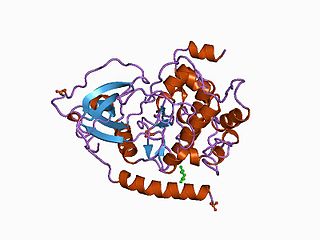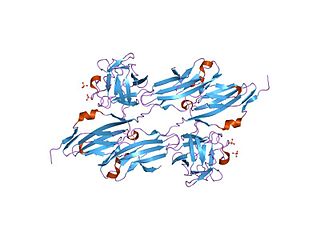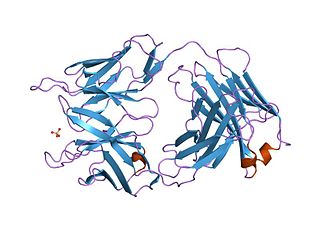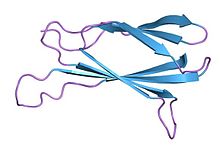
Neural cell adhesion molecule (NCAM), also called CD56, is a homophilic binding glycoprotein expressed on the surface of neurons, glia and skeletal muscle. Although CD56 is often considered a marker of neural lineage commitment due to its discovery site, CD56 expression is also found in, among others, the hematopoietic system. Here, the expression of CD56 is mostly associated with, but not limited to, natural killer cells. CD56 has been detected on other lymphoid cells, including gamma delta (γδ) Τ cells and activated CD8+ T cells, as well as on dendritic cells. NCAM has been implicated as having a role in cell–cell adhesion, neurite outgrowth, synaptic plasticity, and learning and memory.

The immunoglobulin domain, also known as the immunoglobulin fold, is a type of protein domain that consists of a 2-layer sandwich of 7-9 antiparallel β-strands arranged in two β-sheets with a Greek key topology, consisting of about 125 amino acids.

Collagen alpha-5(IV) chain is a protein that in humans is encoded by the COL4A5 gene.

The protein kinase domain is a structurally conserved protein domain containing the catalytic function of protein kinases. Protein kinases are a group of enzymes that move a phosphate group onto proteins, in a process called phosphorylation. This functions as an on/off switch for many cellular processes, including metabolism, transcription, cell cycle progression, cytoskeletal rearrangement and cell movement, apoptosis, and differentiation. They also function in embryonic development, physiological responses, and in the nervous and immune system. Abnormal phosphorylation causes many human diseases, including cancer, and drugs that affect phosphorylation can treat those diseases.

Collagen alpha-3(IV) chain is a protein that in humans is encoded by the COL4A3 gene.

Collagen alpha-2(IV) chain is a protein that in humans is encoded by the COL4A2 gene.

EPH receptor A4 is a protein that in humans is encoded by the EPHA4 gene.

Interleukin 5 receptor, alpha (IL5RA) also known as CD125 is a subunit of the Interleukin-5 receptor. IL5RA also denotes its human gene.

EPH receptor A5 is a protein that in humans is encoded by the EPHA5 gene.

Interleukin 3 receptor, alpha (IL3RA), also known as CD123, is a human gene.

Fibronectin type-III domain-containing protein 3a is a protein that in humans is encoded by the FNDC3A gene.

Fibronectin leucine-rich repeat transmembrane protein FLRT2 is a protein that in humans is encoded by the FLRT2 gene.
The following outline is provided as an overview of and topical guide to immunology:

Fibronectin type III domain-containing protein 5, the precursor of irisin, is a type I transmembrane glycoprotein that is encoded by the FNDC5 gene. Irisin is a cleaved version of FNDC5, named after the Greek messenger goddess Iris.

I-set domains are found in several cell adhesion molecules, including vascular (VCAM), intercellular (ICAM), neural (NCAM) and mucosal addressin (MADCAM) cell adhesion molecules, as well as junction adhesion molecules (JAM). I-set domains are also present in several other diverse protein families, including several tyrosine-protein kinase receptors, the hemolymph protein hemolin, the muscle proteins titin, telokin, and twitchin, the neuronal adhesion molecule axonin-1, and the signalling molecule semaphorin 4D that is involved in axonal guidance, immune function and angiogenesis.

V-set domains are Ig-like domains resembling the antibody variable domain. V-set domains are found in diverse protein families, including immunoglobulin light and heavy chains; in several T-cell receptors such as CD2, CD4, CD80, and CD86; in myelin membrane adhesion molecules; in junctional adhesion molecules (JAM); in tyrosine-protein kinase receptors; and in the programmed cell death protein 1 (PD1).

Monobodies are synthetic binding proteins constructed using a fibronectin type III domain (FN3) as a molecular scaffold. Specifically, this class of binding proteins are built upon a diversified library of the 10th FN3 domain of human fibronectin. Monobodies are a simple and robust alternative to antibodies for creating target-binding proteins. The hybrid term monobody was coined in 1998 by the Koide group who published the first paper demonstrating the monobody concept using the tenth FN3 domain of human fibronectin.

In molecular biology, the protein domain Sterile alpha motif is a putative protein interaction module present in a wide variety of proteins involved in many biological processes. The SAM domain that spreads over around 70 residues is found in diverse eukaryotic organisms. SAM domains have been shown to homo- and hetero-oligomerise, forming multiple self-association architectures and also binding to various non-SAM domain-containing proteins, nevertheless with a low affinity constant.

Leucine-rich repeat neuronal protein 3, also known as neuronal leucine-rich repeat protein 3 (NLRR-3), is a protein that in humans is encoded by the LRRN3 gene.

Fibronectin leucine rich transmembrane protein 1 is a protein that in humans is encoded by the FLRT1 gene.


















